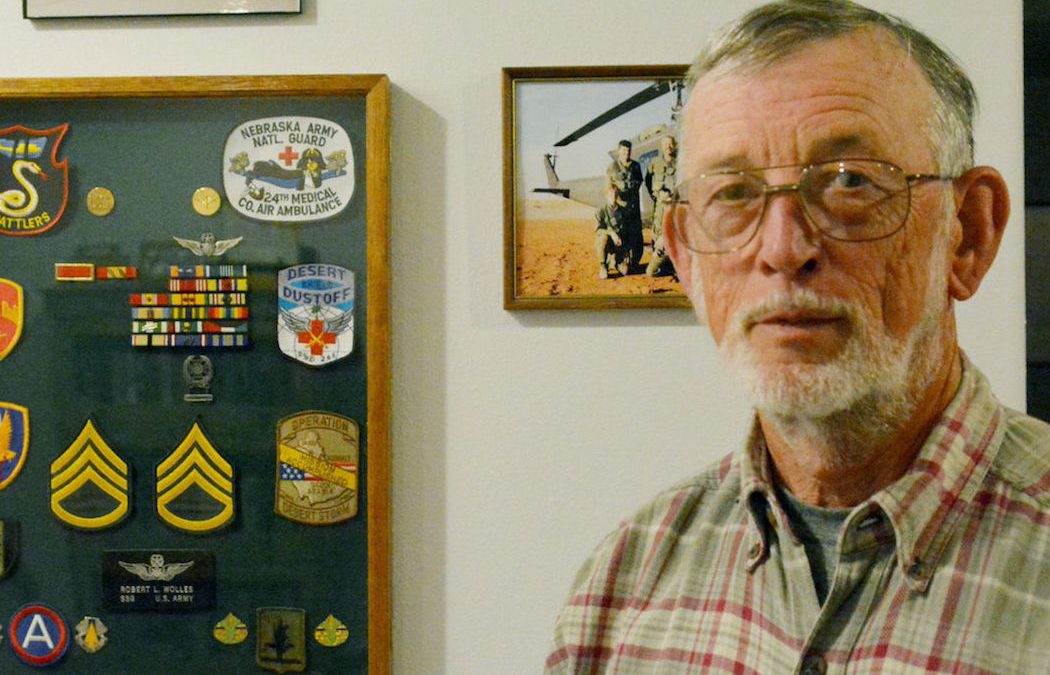Columbus Telegram, Neb. By Tyler Ellyson
COLUMBUS — Bob Wolles considers himself to be among the lucky ones.
He never had to trudge through the rice paddies and sweltering jungle or sleep in a waterlogged uniform during his year in Vietnam.
“I really had it easy compared to some,” the 70-year-old Columbus man said.
Still, his service in the U.S. Army’s 71st Assault Helicopter Company was far from a smooth ride.
Wolles joined the Army shortly after his graduation from Columbus High School in 1964. The voluntary enlistment allowed him to sign up for aviation mechanic training, instead of letting the draft determine his fate.
“I knew if I got drafted I wouldn’t really have a choice of what field I was going to go into, and I wanted to go into the aviation field,” said Wolles, who spent summers working for a local crop duster and the Columbus airport manager.
In addition to fitting his love for flying, the airplane mechanic job ensured he wouldn’t be lugging heavy equipment through the mug and Viet Cong-filled forests.
But there was no avoiding the dangers in Vietnam. Wolles had plenty of “close calls” while serving as a crew chief and gunner aboard a UH-1D “Huey” helicopter.
He attended aviation mechanic school in Fort Rucker, Alabama, and spent about a year at Fort Ord, California, before getting shipped to Vietnam. Although Wolles was trained on fixed-wing aircraft, working on helicopters would allow him to reach the rank of E5 instead of E4, so he made the switch.
“That was a no-brainer,” said Wolles, who took a two-week crash course in helicopter mechanics following his deployment to southeast Asia in March 1966.
When Wolles returned to Bien Hoa Air Base, located about 20 miles north of Saigon in south-central Vietnam, he was named crew chief for a Huey primarily tasked with transporting supplies and troops in an area from the Cambodian border to Saigon to about 100 miles north of the major city.
“Every time that aircraft flew, I flew with it,” said Wolles, who was joined by a pilot, co-pilot and another gunner who manned the M60 machine gun on the chopper’s right side.
The transport helicopters frequently came under enemy fire, but that was just part of the job for Wolles and his crew members.
“When you’re 18 years old you don’t really think about the dangers of it,” he said. “You just look at it like an adventure.”
“Now that I look back on it, if I would have worried about going out and getting shot every time I went on a mission I would have probably wound up in an insane asylum somewhere,” Wolles added.
Among the close calls, one is particularly vivid in the former crew chief’s mind.
It was 40 days before he was set to return to the U.S. and his helicopter was part of a convoy extracting troops near the northern edge of Saigon.
On the third trip in, something didn’t feel right, Wolles said. The choppers started taking enemy fire.
Two infantrymen and a gunner inside Wolles’ Huey were struck by bullets, including one soldier who was hit in the head.
Wolles secured his machine gun then reacted with a maneuver he still can’t fully explain.
He swung himself outside the moving helicopter before being pulled back into the crowded cabin by an infantryman. It was the only way to reach the soldier with the most-severe injury and provide immediate medical treatment.
“To this day I don’t know how I did it,” he said.
Then the helicopter’s engine blew, forcing a crash landing into a rice field. Wolles credits the pilots for avoiding the wooden dikes that surround the paddies and likely saving the lives of everyone aboard.
“Our pilots did a hell of a job,” he said.
An inspection of the bullet-riddled helicopter revealed it was hit about 15 times, including twice in the engine, once in the oil tank and a couple of times along the tail rotor drive shaft.
“That was memorable there,” Wolles said. “I don’t think I’ll ever forget that one.”
Wolles left Vietnam in March 1967 and spent about a decade away from the military until the day a helicopter flew overhead while he was riding a horse at his rural Columbus home.
“That kind of got the bug going in me again,” he said.
The professional firefighter joined the National Guard’s 24th Medical Company, an air ambulance unit based in Lincoln, and served another 17 years, including six months in Saudi Arabia during Operation Desert Shield in the early 1990s.
The Gulf War, he said, “wasn’t anywhere close” to the experience from Vietnam.
“Really, it was boring, to tell you the truth,” he said.
Wolles, who will be among the 650 veterans on board Monday’s Nebraska Vietnam Veterans Flight to Washington, D.C., also knows his time in Vietnam could have ended much differently.
The 71st Assault Helicopter Company relocated to Chu Lai Air Base in 1967 and suffered significant casualties after the North Vietnamese and Viet Cong launched the Tet Offensive in early 1968.
“I was just lucky, plain and simple,” Wolles said.
Like what you just read?
Subscribe today for the best in-depth coverage of local news, sports and entertainment.
View our subscription options ___
(c)2017 the Columbus Telegram (Columbus, Neb.)
Visit the Columbus Telegram (Columbus, Neb.) at www.columbustelegram.com
Distributed by Tribune Content Agency, LLC.
This article is written by TYLER ELLYSON from Columbus Telegram, Neb. and was legally licensed via the Tribune Content Agency through the NewsCred publisher network. Please direct all licensing questions to legal@newscred.com.
© Copyright 2018 Columbus Telegram, Neb.. All rights reserved. This material may not be published, broadcast, rewritten or redistributed.

